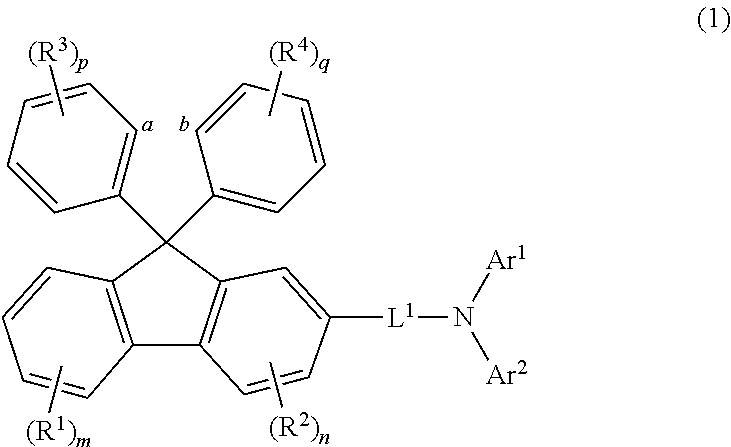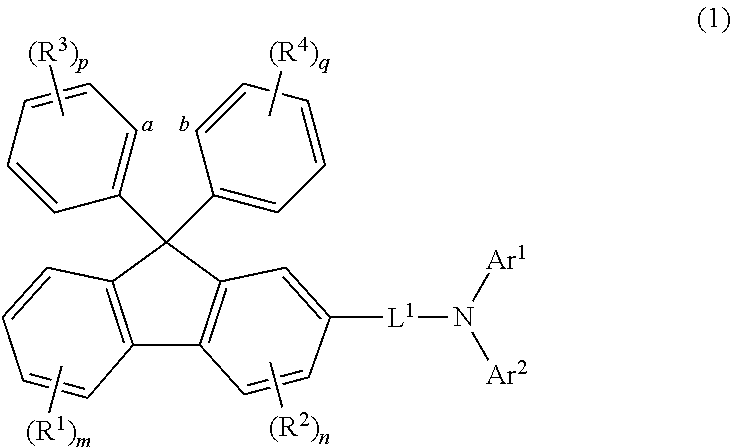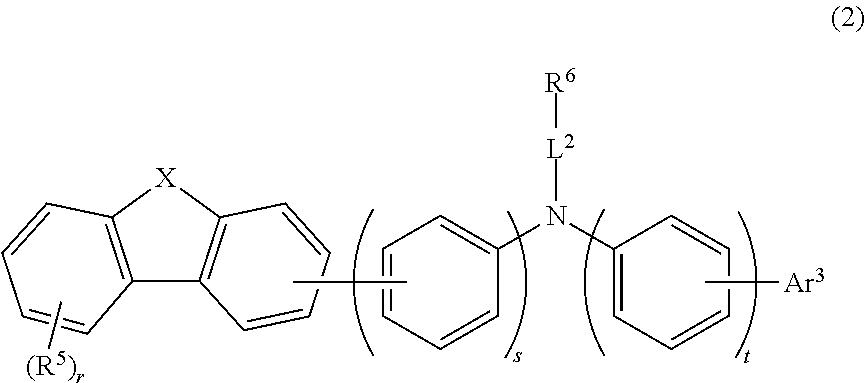Organic electroluminescent element
- Summary
- Abstract
- Description
- Claims
- Application Information
AI Technical Summary
Benefits of technology
Problems solved by technology
Method used
Image
Examples
example 1-1
Production of Organic EL Device
[0163]A glass substrate with ITO transparent electrode lines having a dimension of 25 mm×75 mm×1.1 mm in thickness (produced by Geomatec Co., Ltd.) was subjected to ultrasonic cleaning in isopropyl alcohol for 5 minutes and further subjected to UV (ultraviolet) ozone cleaning for 30 minutes.
[0164]The glass substrate with ITO transparent electrode lines thus cleaned was mounted on a substrate holder of a vacuum vapor deposition apparatus, and the electron accepting compound (A) shown below was vapor-deposited on the surface having the transparent electrode lines formed thereon to cover the transparent electrode, thereby forming a film A having a thickness of 5 nm. An aromatic amine derivative (X1) as a first hole transporting material shown below was vapor-deposited on the film A, thereby forming a first hole transporting layer having a thickness of 160 nm. Subsequent to the formation of the first hole transporting layer, an aromatic amine derivative (H...
examples 1-2 to 1-12
[0168]In Examples 1-2 to 1-12, organic EL devices were produced in the same manner as in Example 1-1 except that the following aromatic amine derivatives shown in Table 1 were used as the first hole transporting material and the second hole transporting material in Example 1-1.
example 2-1
Production of Organic EL Device
[0172]A glass substrate with ITO transparent electrode lines having a dimension of 25 mm×75 mm×1.1 mm in thickness (produced by Geomatec Co., Ltd.) was subjected to ultrasonic cleaning in isopropyl alcohol for 5 minutes and further subjected to UV (ultraviolet) ozone cleaning for 30 minutes.
[0173]The glass substrate with ITO transparent electrode lines thus cleaned was mounted on a substrate holder of a vacuum vapor deposition apparatus, and the electron accepting compound (A) shown below was vapor-deposited on the surface having the transparent electrode lines formed thereon to cover the transparent electrode, thereby forming a film A having a thickness of 5 nm. The aromatic amine derivative (X1) as a first hole transporting material was vapor-deposited on the film A, thereby forming a first hole transporting layer having a thickness of 65 nm. Subsequent to the formation of the first hole transporting layer, an aromatic amine derivative (H6) shown bel...
PUM
| Property | Measurement | Unit |
|---|---|---|
| Electric potential / voltage | aaaaa | aaaaa |
| Efficiency | aaaaa | aaaaa |
Abstract
Description
Claims
Application Information
 Login to view more
Login to view more - R&D Engineer
- R&D Manager
- IP Professional
- Industry Leading Data Capabilities
- Powerful AI technology
- Patent DNA Extraction
Browse by: Latest US Patents, China's latest patents, Technical Efficacy Thesaurus, Application Domain, Technology Topic.
© 2024 PatSnap. All rights reserved.Legal|Privacy policy|Modern Slavery Act Transparency Statement|Sitemap



